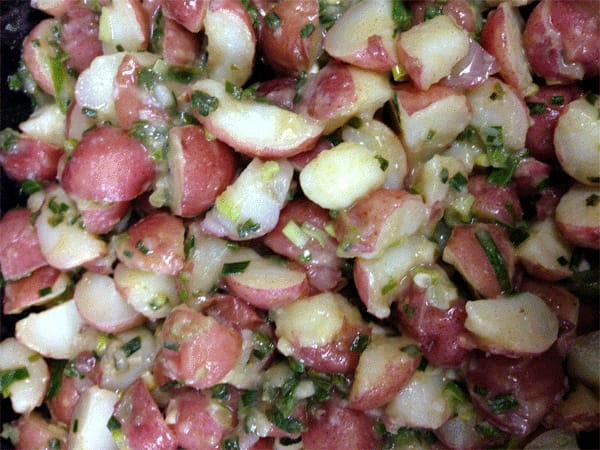
Potato salads are one of the most popular items on summertime picnic tables. Supermarkets sell them by the bucket but if you are nutrition conscious, you might find that the store-bought varieties often have too much sugar, vinegar, salt or fat. With homemade potato salad, you have control over the taste and you can make it much more wholesome.
The most familiar potato salad is heavily coated with mayonnaise. Yet there is another kind of potato salad, popular in Mediterranean lands, which features potatoes dressed with vinaigrette. When made with flavorful oil, these salads can be just as delicious as old-fashioned mayonnaise-dressed ones. A case in point is the colorful Lebanese potato salad with tomatoes, mint and green onions (see recipe below), or the French potato salad with watercress or other fresh herbs with a touch of white wine.
Vinaigrette is lighter-textured and lower in fat and cholesterol than mayonnaise. Besides, it’s more fluid, and therefore you need much less sauce to moisten the potatoes. By choosing buttery tasting Yukon Gold or other flavorful, good quality yellow-, white- or red-skinned potatoes, you can be frugal with the amount of dressing you add.
Basic potato salad is usually accented with onions. You can use yellow onions but red, sweet or green onions make a finer salad. Parsley adds a fresh herbaceous touch, and other herbs like chives, mint, cilantro, tarragon and basil give the salads a lively flavor.
Colorful cooked vegetables like beets, carrots or peas are a welcome addition, contributing to the salad’s taste, appearance and nutrition; add all three, and you have a traditional Russian potato salad. Zesty condiments such as pickled cucumbers, capers, black or green olives or chopped anchovies ensure that the salad won’t be bland.
For easy preparation and good flavor, cook the potatoes in their skins and peel them after cooking; or leave the peel on if it is tender, to benefit from its nutrients. To speed up the cooking, cut large potatoes in half. Be sure the potatoes are cooked just right by checking them with a knife. Undercooked potatoes do not taste good; but overcooked spuds fall apart when cut and when tossed with the dressing.
You can make the vinaigrette dressing according to the classic French proportions of three tablespoons oil for every tablespoon of vinegar or lemon juice. For a lower-fat version, use only two tablespoons of oil and, if the dressing tastes too sharp, add a teaspoon or two of water. Vary the flavors by using walnut oil or extra virgin olive oil and tarragon vinegar or other herb vinegars.
A useful French trick for adding flavor to potato salads is to briefly marinate the cooked potatoes while they are still warm, either in a mixture of white wine and a little oil, or in part of the vinaigrette dressing.
Serving temperature makes a difference in the quality of your potato salads. Most people serve them cold. However, very cold dressing usually congeals and makes the salad appear dry. If you taste the salad straight from the refrigerator, you might think it needs moistening and you’ll be tempted to add more dressing. The salad tastes best if you let it stand at room temperature for about fifteen minutes before serving. Even better, serve it while it’s still lukewarm, so the potatoes have that delicious, fresh-cooked flavor.
Faye Levy is the author of Healthy Cooking for the Jewish Home (Morrow), 1,000 Jewish Recipes (Wiley) and Jewish Cooking For Dummies (Wiley).
The words of this author reflect his/her own opinions and do not necessarily represent the official position of the Orthodox Union.
